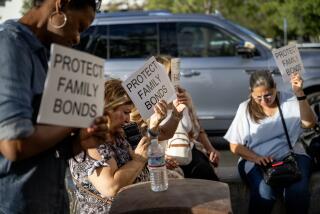Theories about family trees have branch managers out on a limb
- Share via
Being an innumerate (a person who lacks the mentality to deal with mathematical concepts), perhaps I shouldn’t tire my mind by worrying about the number of ancestors each of us has.
As reader George O. Morrison recently pointed out, since each of us has two parents, four grandparents, eight great-grandparents, and so on, going back to the year 1000 and figuring three generations per century, each of us would have 1,073,741,824 direct ancestors. But there were not that many people on Earth in AD 1000.
I worried it back even further than that. If each of us has an ever increasing number of ancestors, how do we narrow it down to the original two--Adam and Eve?
I should point out that my figures may be unreliable, even if I have taken them from some expert source. I am such an innumerate that I can’t even sense whether a calculation is in the right ball park.
For example, in discussing large numbers the other day I noted that “$1 lent at 6% interest compounded from the beginning of the Christian era would be $1,809,041 plus 42 zeroes.”
Jim Jackson of Tehachapi, professor emeritus, UCLA, and several other readers, have pointed out that the correct sum is $1,809,041 followed by 44 zeroes (or digits), not 42--a difference of about 179,095,000,- 000,000,000,000,000,000 trillions of trillions of dollars.
“I hope Mrs. Smith balances your checking account,” writes George Matter of Fullerton, “because if you continually make mistakes by factors of 100 you will be in trouble.”
In times like these what’s all the fuss over a trivial mistake of 179,095,000,000,000,000,000,000,000 trillions of trillions? I’m not even counting that against my annual limit of two errors.
Actually, I meant 1 cent at 6%, not $1--(correctly calculated in a previous column).
And I had no doubt that greater minds than mine had grappled with the question of our theoretical number of ancestors.
Evidently I wasn’t too far off in suggesting that we are all probably cousins, sharing common ancestors.
Bob Kingett of Avalon writes that in researching his family’s genealogy he went back 1,000 years, figuring four generations a century, and calculated that each would have had 68 billion ancestors--”obviously impossible.”
“I arrived at several conclusions,” he says, “one being that we in the United States are all related--cousins, even those who have only just arrived and married into an American family, their children blood relatives of everyone else, no matter their race; and by extension, to everyone else throughout the world today. . . .”
William H. Easton of Westlake Village, a geologist and paleontologist, notes that, going back through 60 generations to the time of Christ, each of us would have 960 quadrillion ancestors. (I do not vouch for any of these figures.)
“Accurate genealogies show that intermarriage of various degrees of cousins reduces the number of actual ancestors. Kaiser Wilhelm theoretically could have had 512 ancestors (at a certain point) but actually had only 162.”
Martin F. Parsons of Baldwin Park recalls a book by Guy Murchie, “The Seven Mysteries of Life,” in which he considers “the interrelatedness of all creatures.”
Murchie concludes that “the family trees of all of us, of whatever origin or trait, must meet and merge into one genetic tree of all humanity by the time they have spread into our ancestries for about 50 generations.”
Parsons concludes: “A believable case is built for our common cousinhood.”
Peg Morell of Buena Park has some personal insight into this phenomenon, since her mother and her mother’s sister married brothers.
She points out that the children of those marriages would have exactly the same grandparents, and “no other families are brought into the fold.”
“Adding to your thought that cousins do marry,” she says, “a family such as ours could have reduced the ancestor pool even further by intermarriage, a situation discussed by the various cousins in our family when, as children, we tried to imagine if life was any different for people with the normal set of great-grandparents. . . .”
You may remember that I was concerned over the question of Cain’s wife. If all humanity sprang from Adam and Eve, as Genesis tells us, where did their sons and daughters find spouses? Is it not implied that brother married sister, and that all of us therefore are the children of incest?
Phil Sherman of Whittier sends me a copy of the Watchtower, a publication of Jehovah’s Witnesses, which purports to answer that conundrum.
“There were no other races of humankind,” it says, “no family of humans predating man, or having a separate origin, as some have conjectured in trying to answer the question about the origin of Cain’s wife. . . . The inevitable conclusion is, then, that Cain married one of his sisters. . . .”
Then it asks the critical question. “Was God fostering what is now called incest by arranging matters so that the first children of Adam would marry one another--brothers marrying sisters? No. For, in Adam’s original perfect state his children would have been born in perfection. There would have been no family weaknesses to be passed on and accentuated by the marriage of near relatives, as is the case today, when the sinful human race has greatly deteriorated and many genetic defects exist. . . .”
That is an ingenious rationalization of what must be an ancient theological problem.
But I am not persuaded. After all, Cain murdered his brother out of sheer jealousy, and it seems to me there must have been some bad seed there.
Maybe that’s why, even though we’re all cousins, we keep killing one another.
More to Read
Sign up for Essential California
The most important California stories and recommendations in your inbox every morning.
You may occasionally receive promotional content from the Los Angeles Times.










